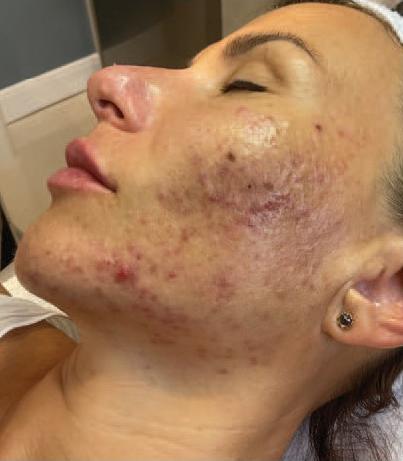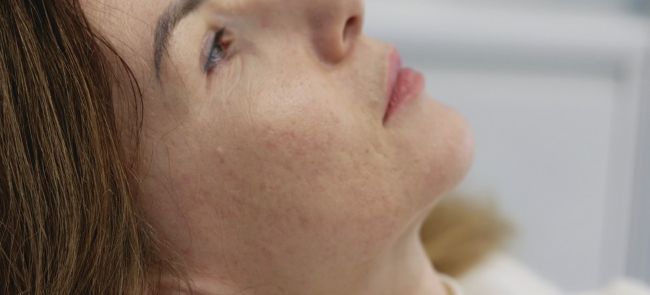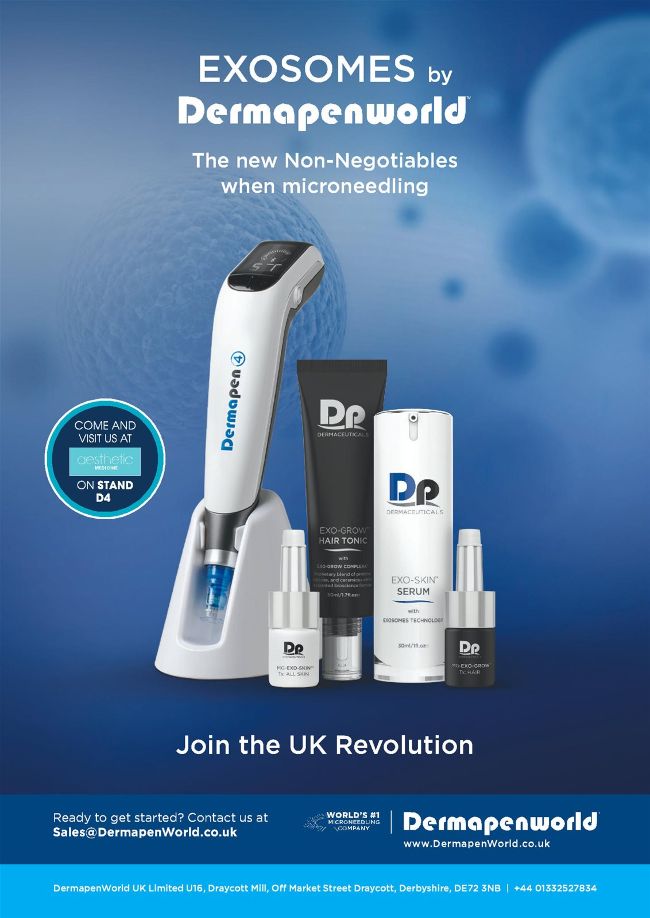CLINICAL
Treating
ADULT ACNE AND SCARRING
Dr Olha Vorodukhina outlines different treatment options for adult acne and acne scarring
DR OLHA VORODYUKHINA
Dr Olha Vorodyukhina BDS is a dental surgeon and aesthetic practitioner, as well as clinical lead at Cosmetic Courses and faculty member at Sinclair and Evolus. She is also the owner of Angels Twelve clinic and a partner at Cosmetic Centre. Additionally, she is the author of the book Beyond the Mirror.
Acne affects 54% of the adult population in the UK at some point in their life.1,2 A review published in the Journal of the American Academy of Dermatology suggested that acne affects around 15-45% of women and 5-20% of men aged over 25.3 Acne not only has a negative impact on facial appearance, but when not addressed and treated correctly it can cause further problems such as scarring, anxiety or even mental health concerns. Some research even suggests there is a link between severe acne and suicide attempts.4
Often adult patients present to aesthetic practices with acne problems after unsuccessful previous treatments, with multiple attempts to find a solution by using a variation of cosmetic skincare. Spending time educating patients, giving healthy lifestyle advice and developing good habits, as well as working closely together with a multidisciplinary team, are key factors in successful treatment outcomes.
CAUSES OF ACNE
Before deciding on a treatment plan, it is important to understand the common causes of adult acne:2
Hormonal fluctuations
Menstrual cycle: Hormonal changes during the menstrual cycle can lead to breakouts in some women.
Pregnancy: Pregnancy-related hormonal changes may cause acne in some women.
Polycystic ovary syndrome (PCOS): Hormonal imbalances associated with conditions like PCOS can contribute to acne.
Menopause: Hormonal changes associated with menopause can lead to the development of acne in some women.
Stress: Stress triggers the release of certain hormones (such as cortisol ), which can stimulate oil production and lead to acne.
Diet: Foods with a high glycaemic index or dairy products may contribute to acne in some individuals.
Cosmetics and skincare products: Certain makeup or skincare products may clog pores and contribute to acne, especially if they are comedogenic.
Medications: Some medications, such as steroids, lithium and certain anticonvulsants, can trigger acne as a side effect.
Genetics: A family history of acne may increase the likelihood of developing adult acne.
Occupational and environmental factors: Exposure to certain pollutants, high humidity or working in an environment with oils and greases can contribute to acne.
Overactive oil glands: Increased oil (sebum) production can clog pores and lead to the formation of acne lesions.
Bacterial Infections: The bacterium propionibacterium acnes (P. acnes) is a normal resident on the skin. However, in certain conditions, it can multiply and contribute to acne.
ADDRESSING ACTIVE ADULT ACNE
There are several treatment options for adult acne, including injectable treatments, chemical peels or energy-based devices. It’s important to note that the specific causes of adult acne can vary from person to person, and addressing it may require a multifaceted approach.
Topical or injectable treatments Topical treatments
containing ingredients such as retinoids, salicylic acid or benzoyl peroxide, tretinoin can be effective for managing acne. In some cases, injectable corticosteroids may be used to reduce inflammation in specific acne lesions.5-8
Facials and chemical peels
Extraction facials effectively remove impurities and unclog pores through deep exfoliation. Chemical peels, including those containing salicylic acid, are proven methods to exfoliate the skin, clear pores and address acne concerns. Proper skin analysis is crucial, and adherence to manufacturer guidelines is essential for safe and effective treatment. Additionally, special attention and tailored skin preparation is necessary when administering peels on individuals with diverse skin tones to ensure optimal outcomes and minimise potential risks,5-7 such as skin pigmentation, discoloration and post treatment inflammation.
Laser and light therapies
Various laser and light-based treatments such light emitting diode (LED) and intense pulsed light (IPL) can target bacteria, reduce inflammation and promote collagen production. These treatments may be beneficial for inflammatory acne because fractional laser treatments create micro-injuries to the skin to stimulate collagen production and promote skin renewal.5-7,9
Supplementation
While a balanced and healthy diet is crucial for maintaining overall skin health, there is some evidence to suggest that certain additional supplements may also be beneficial in reducing acne.10 Of course, this is dependent on the patient and their medical history and lifestyle.
Zinc is an essential mineral with anti-inflammatory properties. It plays a role in wound healing and may help reduce inflammation associated with acne.
Vitamin A is important for skin health and cell turnover. Prescription-strength retinoids, derived from vitamin A, are commonly used to treat acne.
Omega-3 fatty acids, found in fish oil and flaxseed oil, have anti-inflammatory properties and may help reduce inflammation associated with acne. They are also essential for overall skin health.
Probiotics are beneficial bacteria that promote gut health. Some studies11-13 suggest a connection between gut health and skin conditions, including acne. Probiotic supplements may help balance the gut microbiota and potentially improve skin health.
Vitamin D is important for immune function, and there is some evidence to suggest that maintaining optimal vitamin Dlevels may have a positive impact on inflammatory skin conditions, including acne.
Vitamin E is an antioxidant that may help protect the skin from oxidative stress. While research on its specific role in acne prevention is limited, it plays a general role in skin health.
Diindolylmethane (DIM) is a compound found in cruciferous vegetables like broccoli and cauliflower. Some research suggests that DIM may help balance hormones, potentially benefiting those with hormonal acne.
B vitamins, particularly B5 (pantothenic acid), are sometimes recommended for acne. B5 is involved in the metabolism of fatty acids and may help regulate oil production in the skin.21
Glutathione is an antioxidant that is naturally produced in the body and plays a crucial role in protecting cells from damage caused by free radicals and oxidative stress.
TREATMENTS FOR ACNE SCARRING
Treating acne scarring is advisable as soon as active acne is under control and the patients are experiencing less or no minimal break outs.14
It is important to note that some treatments might require downtime, and multiple sessions may be necessary to achieve optimal results. Additionally, protecting the skin from sun exposure is crucial during and after these treatments to prevent further damage. A personalised approach, considering the type and severity of scars, is key to successful acne scar treatment.
Microneedling and radiofrequency
Microneedling alone or with radiofrequency (RF) involves creating tiny micro-injuries to the skin, stimulating collagen production and improving skin texture. It can be effective in reducing the appearance of acne scars and improving overall skin quality.15
Regenerative medicine
The use of polynucleotides, especially in the form of polydeoxyribonucleotide (PDRN), has gained popularity in certain medical and aesthetic treatments. Polynucleotides are sourced from salmon trout DNA and are proven to have regenerative properties.16 In terms of acne scarring treatments, they can stimulate tissue repair and regeneration, have anti-inflammatory properties, improve skin elasticity, increase blood flow and enhance wound healing. PRP can also be used in acne scarring. PRP therapy can help improve the appearance of acne scars by promoting the regeneration of skin tissue, smoothing out rough texture, and reducing the visibility of scars. PRP therapy can also be combined with other treatments for acne scarring, such as microneedling or laser therapy, to enhance results.17
Subcision
This is surgical procedure in which uses a needle to break the fibrous bands that tether the scar to the underlying tissue. This helps release the scar, allowing it to elevate and improve in appearance.18
Dermal fillers
Dermal fillers may be used to fill in depressed acne scars and improve skin contour. For best results, practitioners should use a low viscosity (low G prime and higher elasticity) filler, and deliver small micro bolus injections or line thread intra dermal.19
CASE STUDY
A 45-year-old female patient presented to our clinic concerned about adult acne. She had been suffering from acne on and off since she was teenager, and used to have regular cleansing facial treatments with a dermatologist in Ukraine.
In 2022, she arrived in the UK with her five children and experienced a worsening of her acne, which she attributed to stress, climate change and challenges in finding suitable skincare professionals in her new environment. Her initial consultation took place via video call, followed by an in-person appointment at the clinic. During the consultation, we considered various factors, including her medical history (which was clear), lifestyle and diet. Given her significant stress from fleeing war, settling in a new country, language barriers and adjusting to the UK climate, we devised a twostage plan.
Stage 1
In the first stage, our focus was on treating her active acne over a four-month period. I recommended the Obagi Nu-Derm skincare regimen, which includes a foaming cleansing gel with antibacterial properties to remove sebum and dead skin cells. Tretinoin, a key ingredient, enhances cell turnover to expel comedones and reduce precursor lesions of acne vulgaris.20 Hydrating and SPF products were also advised to maintain skin moisture and provide essential UV protection. Additionally, she underwent Obagi Blue Peel treatments containing salicylic, glycolic and lactic acids to target bacteria and exfoliate the skin.
To complement her skincare routine, I suggested she take oral vitamin Asupplements to reduce the frequency and severity of breakouts. White curcuminoid glutathione by Yutsuba Japan, known for its potent antioxidant and anti-inflammatory properties, was recommended to counteract oxidative stress and inflammation. Furthermore, extraction facials using an ultrasound scrubber were performed to safely and effectively remove comedones and blackheads,21 leaving her skin smoother and clearer.
Stage 2
The second stage involved addressing her acne scarring, with an anticipated timeframe of six months to achieve full results. I employed a combination approach using medical microneedling alongside polynucleotides Plinest for a series of five sessions. The rationale for combining these treatments was to maximise skin regeneration and promote the repair of scar tissues. Each session involved administering intradermal injections of polynucleotides, followed by medical microneedling using a dermal pen device to enhance the delivery and distribution of the polynucleotides.
As part of the comprehensive treatment plan, the patient will undergo an additional two sessions of microneedling and three sessions of RF treatment once per month. Additionally, regular injections of polynucleotides will be administered every three to four months to maintain the desired outcomes.

Before

After: 45-year-old patient after acne treatment and during her acne scarring treatment.
A combination approach
It is important to understand that causes of acne and acne scarring are multifactorial, and combination therapies are often advisable for optimum treatment outcomes. It is important to educate the patient on causes and take a full medical as well as social history, and advise on necessary changes in lifestyle and diet. Managing patient expectations is the key for good long term patient practitioner relations, patient compliance and maintaining results of achieved treatment.
REFERENCE
1. https://click2pharmacy.co.uk/acne-statistics/
2. Adult-onset acne: prevalence, impact, and management challenges, Marco A Rocha 1 , Ediléia Bagatin, Affiliations PMID: 29440921 PMCID: PMC5798558 DOI: 10.2147/CCID.S137794
3. https://ncbi.nlm.nih.gov/pmc/articles/PMC5798558/
4. https://bmj.com/content/341/bmj.c5812
5. Acne Vulgaris: Diagnosis and Treatment, Linda K Oge’ 1 , Alan Broussard 1 , Marilyn D Marshall 1 , Affiliations , PMID: 31613567
6. Low-dose oral isotretinoin for the treatment of adult patients with mild-to-moderate acne vulgaris: Systematic review and meta-analysis, Fatimah Al Muqarrab 1 , Amer Almohssen 2 Affiliations, PMID: 35000295, DOI: 10.1111/dth.15311
7. Treatment of acne in the aesthetic patient: A round table update, Sabrina Guillen Fabi 1 , Katie Beleznay 2 , Diane S Berson 3 , Joel L Cohen 4 , Sandra Lee 5 , Steven H Dayan 6
8. Efficacy and safety of microencapsulated benzoyl peroxide and microencapsulated tretinoin for the treatment of acne vulgaris: Results from two phase 3 double-blind, randomized, vehicle-controlled studies. Del Rosso J, Sugarman J, Green L, Lain T, Levy-Hacham O, Mizrahi R, Gold LS. J Am Acad Dermatol. 2023 Oct;89(4):719-727. doi: 10.1016/j.jaad.2023.05.093. Epub 2023 Jun 2
9. [Pulsed dye laser treatment of acne. Study of clinical efficacy and mechanism of action] [Article in Spanish] A Harto 1 , I García-Morales, P Belmar, P Jaén
10. Pub med Acne and diet, Ronni Wolf 1 , Hagit Matz, Edith Orion, Affiliations PMID: 15556724 DOI: 10.1016/j.clindermatol.2004.03.007
11. Role of nutritional supplements in selected dermatological disorders: A review, Kabir Sardana 1 , Soumya Sachdeva 1 , Affiliations PMID: 34564936 DOI: 10.1111/jocd.14436
12. The increasing importance of the gut microbiome in acne vulgaris, Ruqaiyyah Siddiqui 1 , Zinb Makhlouf 1 , Naveed Ahmed Khan 2 , Affiliations PMID: 35711021 DOI: 10.1007/s12223- 022-00982-5
13. Acne Supplementation: Probiotics, Vitamins, and Diet, Camilla Chello 1 , Claudio Conforti, Caterina Dianzani, Affiliations PMID: 36896693
14. Acne and acne scarring - the case for active and early intervention, Greg Goodman
15. Microneedling as a Treatment for Acne Scarring: A Systematic Review Nisma Mujahid 1 , Faizah Shareef 1 , Mayra B C Maymone 1 , Neelam A Vashi 1 2 Affiliations PMID: 31356435 DOI: 10.1097/DSS.0000000000002020
16. Preliminary Prospective and Randomized Study of Highly Purified Polynucleotide vs Placebo in Treatment of Moderate to Severe Acne Scars Antonino Araco 1 , Francesco Araco Affiliations PMID: 33755110 DOI: 10.1093/asj/sjab125
17. Platelet-Rich Plasma (PRP): Current Applications in Dermatology, Jason Emer 1
18. Subcision in acne scarring: A review of clinical trials, Najmeh Ahramiyanpour 1 2 , Fatemeh Rastaghi 1 , Seyed Yasamin Parvar 3 4 , Ali Karimi Sisakht 5 , Seyed Ali Hosseini 6 , Maliheh Amani 7
Affiliations, PMID: 36315903, DOI: 10.1111/jocd.15480
19.Update on acne scar treatment: Yssra S Soliman 1 , Rebecca Horowitz 2 , Peter W Hashim 3 , John K Nia 3 , Aaron S Farberg 3 , Gary Goldenberg 4 , Affiliations PMID: 30138491
20. Tretinoin 0.1% and Benzoyl Peroxide 3% Cream for the Treatment of Facial Acne Vulgaris Christina Kontzias 1 , Mallory Zaino 1 , Steven R Feldman 1
21. https://www.ascpskincare.com/updates/blog-posts/what-are-facial-extractions
